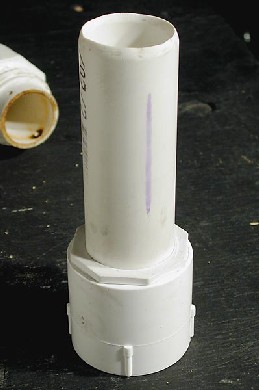Difference between revisions of "Spud cutter"
m (added links) |
|||
| (7 intermediate revisions by 6 users not shown) | |||
| Line 1: | Line 1: | ||
| − | + | A '''spud cutter''' or '''muzzle knife''' is used to cut produce to the diameter of the [[barrel]]. It can be made as an integral part of the barrel, or kept as a separate utensil. | |
| − | It is made by | + | It is made by beveling the outside of the barrel (or a pipe of the same inside diameter) until it forms a sharp edge. In [[combustion cannon|combustions]], is recommended that you add an inner chamfer to your launcher; this cuts a tighter fitting projectile, which increases friction and therefore acts a bit like a [[burst disk]], allowing the [[pressure]] to build before projectile starts to move. |
| − | However, there are | + | However, there are deficiencies in the typical PVC 'cutter, mainly that it is a relatively soft material and therefore can neither be sharpened very well nor hold an edge. Many have attempted to counter this by: |
| − | * | + | * Serrating their cutter. (Examples: [http://www.spudfiles.com/official_pics/loc_04.jpg]) |
| − | * Making them out of steel. | + | * Making them out of steel. |
| + | [[Image:Aluminum Cutter.jpg|left|thumb|250ps|An Aluminum Spud Cutter]][[Image:Slug cutter.jpg|right|thumb|250ps|A PVC Slug Cutter]][[Category:Accessories]] | ||
Latest revision as of 13:45, 1 June 2008
A spud cutter or muzzle knife is used to cut produce to the diameter of the barrel. It can be made as an integral part of the barrel, or kept as a separate utensil.
It is made by beveling the outside of the barrel (or a pipe of the same inside diameter) until it forms a sharp edge. In combustions, is recommended that you add an inner chamfer to your launcher; this cuts a tighter fitting projectile, which increases friction and therefore acts a bit like a burst disk, allowing the pressure to build before projectile starts to move.
However, there are deficiencies in the typical PVC 'cutter, mainly that it is a relatively soft material and therefore can neither be sharpened very well nor hold an edge. Many have attempted to counter this by:
- Serrating their cutter. (Examples: [1])
- Making them out of steel.

